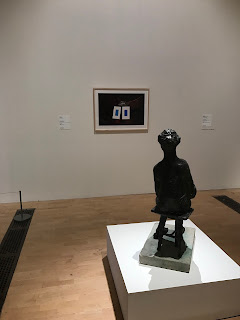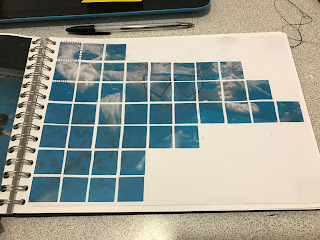 I had the idea of cutting an
image up into rectangles with each one getting smaller and smaller and then
moving each piece slightly to the right. This composition was not successful, I
really struggled with the process as I initially used a ruler but found it kept
moving or the paper kept moving so I did it free hand which then obviously
wasn’t straight which I think ruined the overall effect of the piece and
disrupted the sequence and balance of the composition. It also failed to
succeed as I thought it would change the shape of the figure in a weird way
however it actually covered up most of the figure in the photograph because of
how I stuck it down which meant that the focus actually became the way it was
put on the page rather than a distorted
figure which was not what I wanted to achieve with this piece.
I had the idea of cutting an
image up into rectangles with each one getting smaller and smaller and then
moving each piece slightly to the right. This composition was not successful, I
really struggled with the process as I initially used a ruler but found it kept
moving or the paper kept moving so I did it free hand which then obviously
wasn’t straight which I think ruined the overall effect of the piece and
disrupted the sequence and balance of the composition. It also failed to
succeed as I thought it would change the shape of the figure in a weird way
however it actually covered up most of the figure in the photograph because of
how I stuck it down which meant that the focus actually became the way it was
put on the page rather than a distorted
figure which was not what I wanted to achieve with this piece. I did a monochrome photocopy to
see if the piece looked more successful in black and white. It didn’t really
work as the original composition in colour was not successful because of the
way I had cut the shapes which
then
transferred onto the black and white copy. I do however prefer the coloured
version as you can see more clearly what is in the photograph where as the
figure seems to blend in with the background of the image in this composition because the
dark tones are very similar.
I did a monochrome photocopy to
see if the piece looked more successful in black and white. It didn’t really
work as the original composition in colour was not successful because of the
way I had cut the shapes which
then
transferred onto the black and white copy. I do however prefer the coloured
version as you can see more clearly what is in the photograph where as the
figure seems to blend in with the background of the image in this composition because the
dark tones are very similar.
I decided to print the image on
acetate and use the same technique I have been doing previously, however I
decided to put and image underneath to see what effect it would have on the
piece. I think that this piece is very successful and I love how it gives it a
pixelated look with the overlaying of the shapes on the right side of the
composition. The piece looks very symmetrical and I think the translucency of
the acetate print works really well with this technique.
I chose the one on the left because the image seemed to flow better and it was moving in the same direction that the figure was leaning to in the photograph. I think the composition was more visually satisfying when going from left to right, perhaps it is a language thing as here we read and write from left to right so maybe it is the familiarity of it that makes it preferable.
As the first try was not
successful I decided to try it again. This time I printed the photograph
slightly bigger and I used a ruler and measurements to cut out each shape. Once
I cut it out I decided to arrange it going right to take a picture and then do
it again but going left so I could compare them and see which one was better. I think this piece is much more
successful than the original now that it has been refined. I really like it and
could see this developing into a potential final outcome.
As I had been experimenting with
stitching things together inspired by my artist Annegret Soltau I decided to
combine it with this piece by stitching the cut out shapes together. I hated
doing this composition, it took me ages to actually finish stitching it as they
were so close together and the cartridge paper was thicker so it was harder to
push the needle through. I don’t feel like this piece is very successful, I
feel like the stitching ruins the composition and upsets the balance of the
piece. The lack of white space between the shapes makes it seem very busy and
takes the focus away from the figure and the technique of the collage which I
am not happy with.
I decided to try the stitching on
this composition again however this time I wanted to use less thread and I
decided to make almost triangle shapes following the direction of the piece so
that the string was perpendicular meeting at a point towards the right. I think
that this composition is much more successful as it appears to be more balanced
and symmetrical, with more space to counteract the photograph.















































